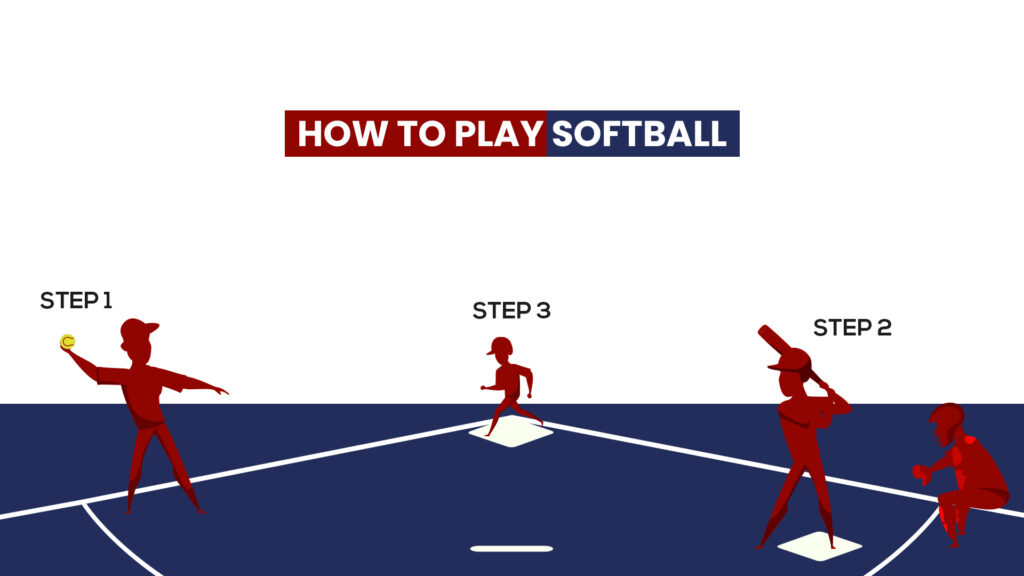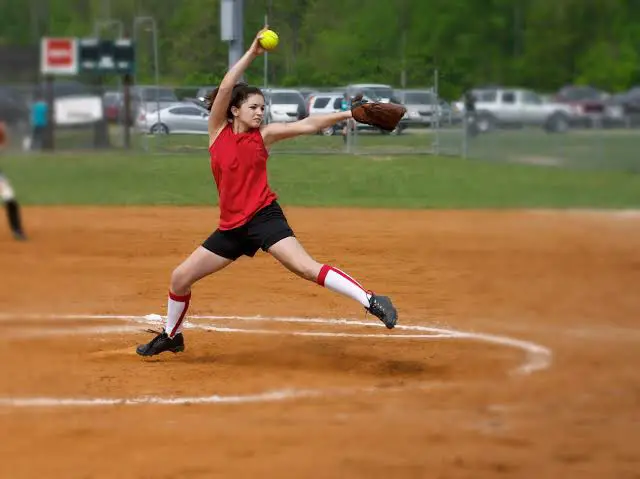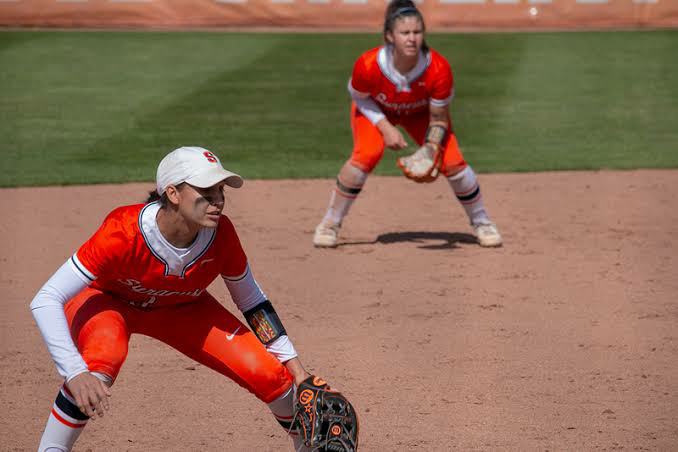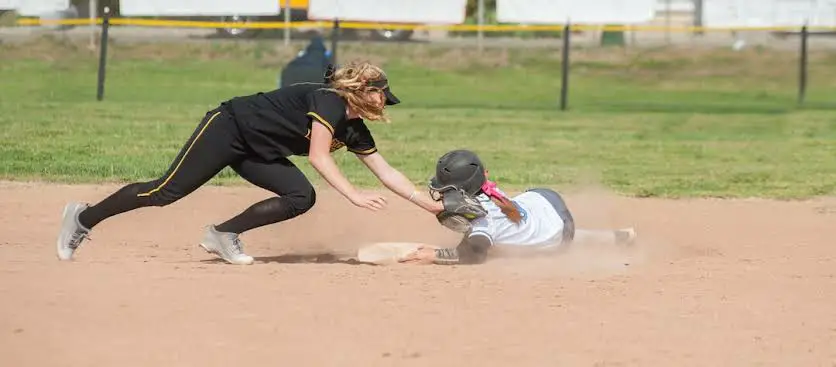Softball, which is very similar to baseball but uses a larger ball, is played on a field with base lengths of 60 feet, a pitcher’s mound that is between 35 and 43 feet away from home plate, and a home run fence that is anywhere from 220 to 300 feet away from home plate. Competitive softball is played at the club, collegiate, and professional levels.

Beginning the Game
Winning a softball game requires mastery of a wide variety of strategies. Every variation of this game has its own set of strategies for batting and bowling. When the umpire shouts, “play ball,” the softball game officially begins. The pitcher waits until the fielders are in their appropriate positions and the batsman is ready before they step up to the pitching plate.
The pitcher throws the ball past the batsman and into the catcher’s glove area behind home plate. There is an underarm motion involved in the throw and the pitch.
Pitching the Ball

Fast-pitch games are characterized by the pitcher’s windmill-like delivery of the ball. The windmill action occurs when pitchers wrap their throwing arm around their body and then unleash the ball at hip level with maximum velocity.
In most cases, the pitcher will aim for the batter’s strike zone to deliver the ball. However, if the batter swings, a pitcher at the highest levels of competition may intentionally throw the ball out of the strike zone.
A “No Pitch” occurs when neither the batter nor the pitcher makes contact with the ball.
A count indicates the number of balls and strikes in softball, with the former always reported first. Three and two make up a full count.
Professional pitchers focus on hitting the inner and outer corners of the plate with fastballs.
The pitcher can make it more difficult for the batsman to hit the ball by changing the height he throws.
A pitcher should strive to unleash all of their strength into each pitch.
Women’s matches in the 1996 Olympics saw pitches go as fast as 118 kilometers per hour. The fastest recorded speed in a men’s match is 140 kph.
Each member of the offensive team (also known as the batting team) takes the field individually to hit the ball, and the sequence in which they do so is known as the batting order.
The batsman is expected to sprint as fast as possible after hitting the ball into fair territory.
The batter is known as a batter-runner when they are in motion from home plate to first.
When she successfully rounds first base, she is officially a base runner.
Fielding

Fielders must try to remove the batsman from the game using three methods: the force out, the tag out, or the fly out.
An out is recorded as a “force out” if the fielder, while in possession of the ball, touches the base that the batter can only reach by running that base.
A fielder gets an automatic force out if they touch a base while holding the ball before the batsman reaches it.
Batters are said to be “tagged out” when they attempt to reach a base already occupied by an opposing player. It’s a fly out when the fielder catches the ball the batter hits. In softball, a fly out is the equivalent of a catch out in cricket.
The catcher’s and first baseman’s mitts have the largest pockets of any boxing glove.
The catcher’s glove has a lot of extra padding. Unlike a first baseman’s glove, a catcher’s glove does not have finger holes.
Middle-sized gloves are standard for outfielders. It’s a lot more compact than the catcher’s gloves.
Most outfielders use gloves that are between 12 and 13 inches in circumference.
The larger glove size allows players to extend their reach and grab the ball from a higher vantage point.
The infielders have the smallest glove size. It measures between 10 and 12 inches in length.
The infielder’s glove is smaller because of the demands of fielding the ball swiftly and throwing it in the appropriate direction. As a result, players may have trouble picking up the ball swiftly and firing it to the right spot if their gloves are too large.
The Duration of the Game
Fastpitch softball games consist of seven innings long, but slow pitch games can have anything from three to seven. In the case of a tie, extra innings are allowed in both events.
The length of a softball game is difficult to estimate because innings are played rather than time. Since leagues have some leeway within the rules to limit how many runs a team can score every inning, slow pitch games are slightly more likely to be shorter than seven-inning games, which can go over two hours.
Terms Used in Softball
Appeal Play
A play on which an umpire cannot render a decision unless a player requests one. The appeal must be made before delivering the following pitch to the batter.
Base Path
A three-foot imaginary line on each side or a direct line between the bases.
Batter’s Box
A region where the batter is confined when in position to help their team score runs.
Batter/Baserunner
A batter who has completed their at-bat but has not yet been put out or reached first base.
An ILLEGALLY tapped ball that was not intentionally swung at but instead tapped slowly within the infield.
Catcher’s Box
The region in which the catcher must remain while the pitcher delivers a pitch.
Dead Ball
The ball is not in play and is not deemed to be in play again until the pitcher gets within eight feet of the pitcher’s mound, and the umpire calls “Play Ball.”
Fair Ball
Any ball hit by a batter that lands in the fair territory between home and first base or home and third base, or that is on or over the fair territory including any section of the first and third base while moving to the outfield, or that reaches any of the bases, or that meets any person (player or umpire), or that goes out of play beyond the outfield wall.
Foul Tip
A foul ball is legally caught if it goes directly from the bat to the catcher’s hand and is not higher than the batter’s head.
Illegally Caught Ball
It happens when a fielder snags a ball that has been hit or thrown at him when his cap, glove, or other equipment is not in its appropriate place.
In Jeopardy
A term denoting that the ball is in play and a player on offense may be put out.
Infield Fly Rule
A fair hit that is caught or, in the judgment of the umpire, could be readily handled by an infielder is not ruled a line drive. Players must occupy first and second base (or all bases) with less than two outs remaining.
Interference
The action of a defensive player that impedes or stops a batter from hitting a thrown ball, or the action of an offensive player that impedes, hinders or confuses a defensive player while attempting to execute a play.
Obstruction
Throwing at a runner legally attempting to advance to the next base while not in control of the ball or while fielding a batted ball.
Out of Play
A ball that has traveled beyond the out-of-bounds line.
Pivot Foot
The foot must remain in touch with the pitcher’s plate until the delivery of the ball.
Play Ball
The umpire’s expression marks the beginning or resumption of play.
Sacrifice Fly
Allowing a runner to advance or score on a fair-fly ball puts the batter or runner out simultaneously.
Turn at Bat
Begins at the moment a player steps into the batter’s box and continues until he is either out or moves to another base.
Time
The term used by the umpire to stop play.
Rules of Softball

Here are the rules of softball:
There are 18 players in a softball team game (9 on each team), and the game lasts for 7 innings. Each team bats and fields twice in each round of an inning. Three outs are required to end each of the two halves of an inning.
The home team bats first. If the score remains tied after seven innings, the game will continue into extra innings until a victor is declared.
The fielding team position will throw the opening pitch. Before releasing the ball, the pitcher in a game of softball must plant both feet firmly on the rubber. A ball underhand is recommended as well. Aside from the pitcher and the two infielders, the defensive lineup consists of a catcher, a shortstop, a first, a second, a third, and three outfielders. The goal is to force the batting team to run out of batters.
From a defensive standpoint, multiple methods exist to get out of the jam. A pitcher can induce a strikeout by throwing three pitches that the hitter swings at but misses. After a batter has batted, they become the runner, and an out is recorded if a fielder catches the ball and races to any base before the batter reaches that base. A fly out is recorded when a fielder catches a ball before it has bounced or touched the ground and is thus considered to have been hit.
A runner can be tagged out if they successfully make it past the base before the ball reaches it, only for the baseman to grab the ball and tag the runner out before the runner can advance to the next base.
Members of the offensive unit, meanwhile, will rotate at bat. Each inning must include the same batting order. If there are male and female players on the team, they should take turns at the front. As previously indicated, the players are referred to as runners after batting. There should be no clockwise or erratic base running; runners must touch all the bases in numerical order. One may, however, bypass the initial basis.
As previously mentioned, a runner can be ruled out for running beyond the infield playing area by more than the allowed allowance of roughly 91 centimeters, in addition to being out by strikeout, force out, fly out, or tag out.
